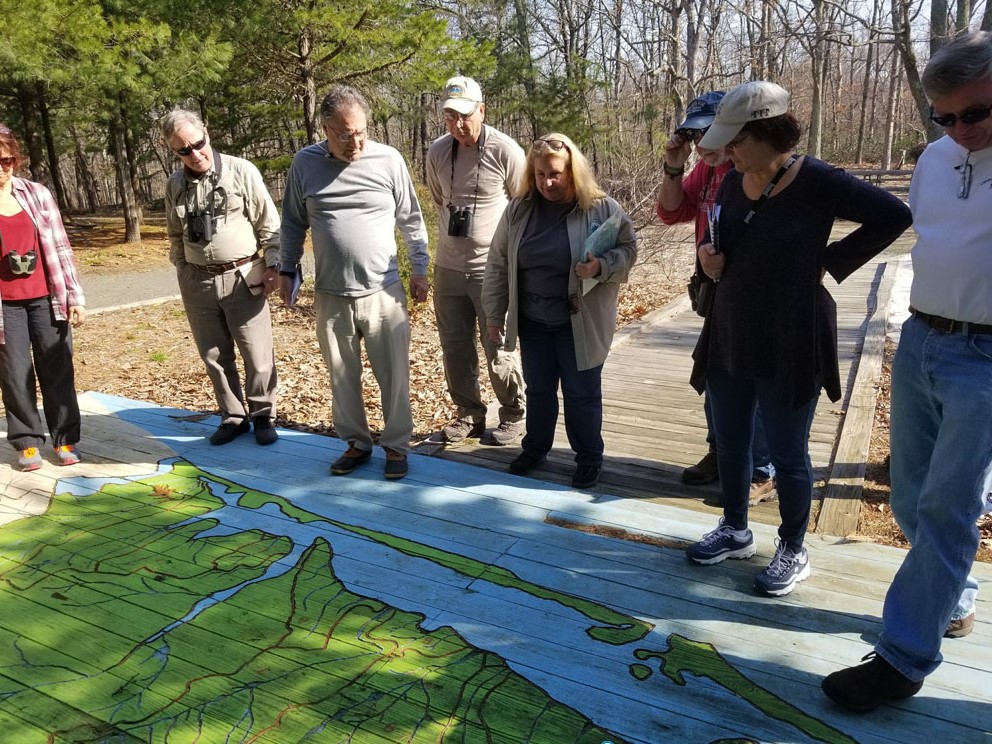
Forest Resource Education Center
The class met at the FREC to explore the Pine Barrens of New Jersey. The trip was from 9am to 3pm and by the time we left, we had to hustle through the final part of the presentation because there is so much to discover there!
We began by meeting Candace Lilly, part time tour guide and staff member at FREC. A former classroom science teacher, she worked at almost every park in the Ocean County Parks system before taking a position with the NJ DEP at FREC. Though it may look like one to casual visitors, FREC is not a park, it is the state tree nursery and tree farm. They collect pine cones and heat them and tumble them to extract seed. Serotinous cones are covered with a resin that must be melted for the cone to open and release seeds. When a fire moves through the forest, the cones open and the seeds are distributed by winds and gravity. The folks at FREC save the seeds and plant them to grow the seedlings and then harvest the saplings which need to be trimmed and grouped on a conveyor belt system. This is a nasty, wet and dirty job, but it’s super important. FREC replaced 350,000 trees that had been damaged or killed after hurricane Sandy in 2012.
When FREC opened 15 years ago they had a full time staff of employees and educators, but due to budget cuts and attrition, only 4 part time employees remain. The trails and grounds are open for public visitors, they host school groups and have free, Forestry in 90 Minutes educational talks on the 2nd Thursday night of every month from 7pm to 8:30pm. Registration is free, but you need to RSVP HERE.
The Barnegat Bay Watershed
Candace brought our group outside to a large wooden deck that featured a map of the Barnegat Bay Watershed. She had cards for each section of the map that had educational facts about the history of each area and it’s physical characteristics. The exercise revealed a lot of local history that I didn’t know.



The Atlantic White Cedar is a low land tree (likes to have wet feet) that’s native to marshy soil close to water in the north east US. It’s timber was over harvested because it was important for building ships and buildings and is now hard to find in the wild. This high quality wood grows very tall and very straight. It’s branches are naturally small, so the knots in the wood are also very small. Most importantly, it’s water and rot resistant. In 1929, the Manasquan inlet was dug to facilitate boat access into the bay and the Manasquan river from the Atlantic ocean. When the fresh water mixed with salt water, the resulting brackish water had a huge effect on the ecology of the area. Because they are so resistant to rot, there are still stands of Atlantic White Cedar “ghost trees” that have been dead for nearly 100 years that can be seen in the area today.
If you have a cedar tree in your yard and don’t live very close to fresh water, it’s likely a red cedar. They are upland trees and like dryer soil conditions.
We found out that the Toms River is 163 square miles and 93 million gallons flow through it per day.
The Jersey Shore was home to lots of salt works, up and down the bay. It was an important product in the port areas because salt was used to preserve and season food as well as to make salt peter, which was used to make gun powder around the time of the revolution. They would allow water to fill large pans or kettles (Kettle Creek?) and then let the water evaporate, leaving the salt behind.
Toms River used to be called Dillon’s Creek. The British wanted colonists to buy salt from them (so they could tax it) and Dillon turned out to be a British spy and sympathizer. He informed the invaders about the changing of the guard so that the British were able to come in and burn the settlement to the ground in 1782. Everything was destroyed except for the local bar and Dillon’s niece’s house.
Did you every hear about Captain Kidd? He was a famous pirate and a local Barnegat Bay legend says that he buried a chest of treasure somewhere on Money Island. People are still searching for it to this day, but it’s never been found. YET!
Here are a few other facts we learned at the watershed map:
- Out of 20 watershed management areas in NJ, The Barnegat Bay watershed is #13.
- Cape May is home of the largest maritime forest in New Jersey
- Manahawkin means “A place with good land” in the language of the Lene Lenape Native Americans
- Garvey boats were used for rum running during prohibition because they could move very fast through shallow marshy waters where larger boats could not follow them. After prohibition Garvey races became a local tradition.
- Tuckerton Creek is very old and was the 3rd created port of entry into the United States.
- In 1920 the first environmental legislation in the state became law preventing the sale of clean fresh water from South Jersey to Philadelphia.


